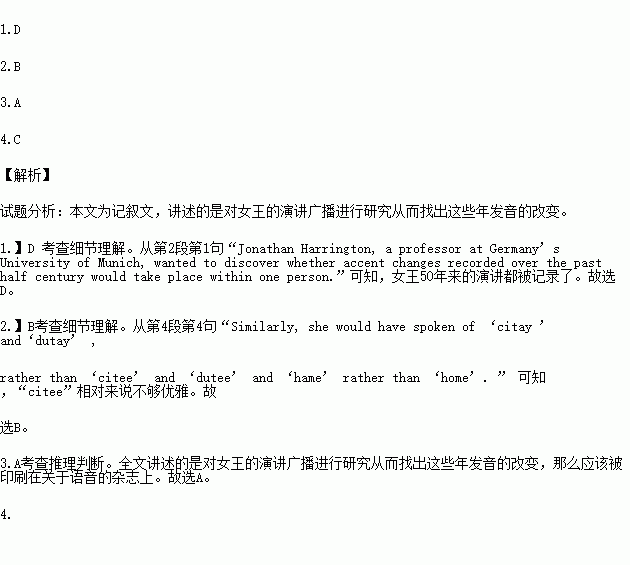题目内容
The Queen’s English is now sounding less upper-class, a scientific study of the Queen’s Christmas broadcasts had found. Researchers have studied each of her messages to the Commonwealth countries since 1952 to find out the change in her pronunciation from the noble Upper Received to the Standard Received.
Jonathan Harrington, a professor at Germany’s University of Munich, wanted to discover whether accent changes recorded over the past half century would take place within one person. “As far as I know, there just is nobody else for whom there is this sort of broadcast records,” he said.
He said the noble way of pronouncing vowels (元音) had gradually lost ground as the noble upper-class accent over the past years. “Her accent sounds slightly less noble than it did 50 years ago. But these are very, very small and slow changes that we don’t notice from year to year.”
“We may be able to relate it to changes in the social classes,” he told The Daily Telegraph, a British newspaper. “In 1952 she would have been heard saying ‘thet men in the bleck het’. Now it would be ‘that man in the black hat’. Similarly, she would have spoken of ‘citay ’ and ‘dutay’ , rather than ‘citee’ and ‘dutee’ and ‘hame’ rather than ‘home’. In the 1950s she would have been ‘lorst’, but by the 1970s ‘lost’.”
The Queen’s broadcast is a personal message to the Commonwealth countries. Each Christmas, the 10-minute broadcast is put on TV at 3 pm in Britain as many families are recovering from their traditional turkey lunch.
The results were published in the Journal of Phonetics.
1.The Queen’s broadcasts were chosen for the study mainly because ______.
A. she has been Queen for many years.
B. she has a less upper-class accent now.
C. her speeches are familiar to many people.
D. her speeches have been recorded for 50 years.
2.Which of the following is an example of a less noble accent in English?
A. “dutay” B. “citee” C. “hame” D. “lorst”
3.We may infer from the text that the Journal of Phonetics is a magazine on _________.
A. speech sounds B. Christmas customs
C. TV broadcasting D. personal messages
4.What is the text mainly about?
A. The Queen’s Christmas speeches on TV.
B. The relationship between accents and social classes.
C. The changes in a person’s accent.
D. The recent development of the English language.
 阅读快车系列答案
阅读快车系列答案
